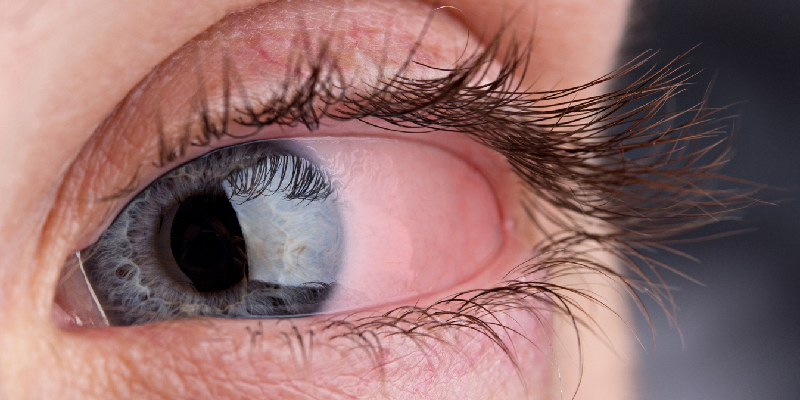Skin conditions that affect your face can not only be aggravating but embarrassing as well. Everyone wants their facial skin to look healthy and smooth, so chronic or recurring blemishes are always frustrating.
A common skin condition in American adults is rosacea. It is characterized by redness and blotchiness. On top of being a cosmetic issue, rosacea can be uncomfortable and even lead to skin damage if severe.1
Rosacea is an inflammatory disease, with symptoms like persistent redness, flushing, and swollen pustules that are characteristic of inflammation. It can occur over a small area or over the entire face. Burning, stinging, dry skin, local fluid retention leading to swelling, and eye irritation may also be experienced by sufferers.1
The causes of rosacea can be complex, and many factors can trigger this type of inflammatory reaction.
How Eyelash Mites May Be Contributing to Your Rosacea?
 One possible cause of rosacea that has been often overlooked until recently is Demodex mites infestation.
One possible cause of rosacea that has been often overlooked until recently is Demodex mites infestation.
Also known as eyelash mites, they have increasingly been found to be associated with several skin and eye disorders, including rosacea. In fact, studies have found that people with rosacea usually have more Demodex mites than the average person – 10 to 20 per square centimeter of skin, as opposed to 1 or 2.2
Demodex mites are microscopic arachnids: eight-legged relatives of spiders that are too small to be seen with the naked eye. They spend most of their lives burrowed within pores and eyelash follicles, eating oil and skin cells, only occasionally venturing out at night.3
Mites are easily passed from person to person through contact with facial skin, which can happen when kissing or hugging. Recent research has found that more than half of young adults have Demodex mites. That number increases with age to more than 80% of adults over the age of 65.
For the majority of cases, Demodex infestations do not cause problems and go unnoticed. However, certain health conditions or environmental factors can cause the population to expand out of control. Over-populations of mites or a stressed immune system can cause an inflammatory response such as rosacea to occur.4
The exact reasons why mites cause inflammation aren’t fully understood. There could be are several likely factors.
Mite activities such as eating skin cells or crawling and scraping their claws could cause micro-damages and skin reactions. When mites burrow deep, the immune system may recognize them or their waste products as invading pathogens and react accordingly. The end result can manifest as the red, blotchy patches of ocular rosacea.5
How to Get Rid of the Mites?
 Eliminating Demodex mites could be helpful in improving many cases of rosacea.
Eliminating Demodex mites could be helpful in improving many cases of rosacea.
The trick is to use a facial cleanser that is powerful enough to reach mites within their burrows, yet safe enough to use for the month or so it takes to fully clear the mite infestation.
Cliradex products have been formulated to meet these requirements. Both Cliradex Foam facial cleanser and Cliradex towelettes contain 4-terpineol, the most important ingredient in tea tree oil. 4-terpineol has been proven to have mite-killing properties, and can effectively clear your eyelash mite infestation while not irritating the delicate skin around your eyes.6
Target the underlying cause of your rosacea with Cliradex, and enjoy fresh-looking, smooth skin once again.
Updated: 11/20/2019
Resources:
- Picardo M, Eichenfield LF, Tan J. Acne and Rosacea. Dermatology and therapy. 2017;7(Suppl 1):43-52.
- Bonnar E, Eustace P, Powell FC. The Demodex mite population in rosacea. J Am Acad Dermatol. 1993 Mar;28(3):443-8.
- Cheng AM, Sheha H, Tseng SC. Recent advances on ocular Demodex infestation. Current opinion in ophthalmology. 2015;26(4):295-300.
- Gonzalez-Hinojosa D, Jaime-Villalonga A, Aguilar-Montes G, Lammoglia-Ordiales L. Demodex and rosacea: Is there a relationship? Indian journal of ophthalmology.2018;66(1):36-38.
- Li J, O’Reilly N, Sheha H, et al. Correlation between ocular Demodex infestation and serum immunoreactivity to Bacillus proteins in patients with Facial rosacea. Ophthalmology. 2010;117(5):870-877.e871.
- Tighe S, Gao YY, Tseng SC. Terpinen-4-ol is the Most Active Ingredient of Tea Tree Oil to Kill Demodex Mites. Translational vision science & technology. 2013;2(7):2.




